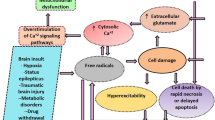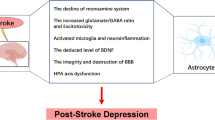Abstract
Neuroinflammation mediated by microglia and oxidative stress play pivotal roles in the development of chronic temporal lobe epilepsy (TLE). We postulated that kainic acid (KA)-Induced status epilepticus triggers microglia-dependent inflammation, leading to neuronal damage, a lowered seizure threshold, and the emergence of spontaneous recurrent seizures (SRS). Extensive evidence from our laboratory suggests that dextromethorphan (DM), even in ultra-low doses, has anti-inflammatory and neuroprotective effects in many animal models of neurodegenerative disease. Our results showed that administration of DM (10 ng/kg per day; subcutaneously via osmotic minipump for 4 weeks) significantly mitigated the residual effects of KA, including the frequency of SRS and seizure susceptibility. In addition, DM-treated rats showed improved cognitive function and reduced hippocampal neuronal loss. We found suppressed microglial activation-mediated neuroinflammation and decreased expression of hippocampal gp91phox and p47phox proteins in KA-induced chronic TLE rats. Notably, even after discontinuation of DM treatment, ultra-low doses of DM continued to confer long-term anti-seizure and neuroprotective effects, which were attributed to the inhibition of microglial NADPH oxidase 2 as revealed by mechanistic studies.








Similar content being viewed by others
References
Ngugi AK, Bottomley C, Kleinschmidt I, Sander JW, Newton CR. Estimation of the burden of active and life-time epilepsy: A meta-analytic approach. Epilepsia 2010, 51: 883–890.
Marcangelo MJ, Ovsiew F. Psychiatric aspects of epilepsy. Psychiatr Clin North Am 2007, 30: 781–802.
Devinsky O, Spruill T, Thurman D, Friedman D. Recognizing and preventing epilepsy-related mortality: A call for action. Neurology 2016, 86: 779–786.
Galanopoulou AS, Buckmaster PS, Staley KJ, Moshé SL, Perucca E, Engel J Jr. Identification of new epilepsy treatments: Issues in preclinical methodology. Epilepsia 2012, 53: 571–582.
Waldbaum S, Patel M. Mitochondrial dysfunction and oxidative stress: A contributing link to acquired epilepsy? J Bioenerg Biomembr 2010, 42: 449–455.
Vezzani A, Friedman A, Dingledine RJ. The role of inflammation in epileptogenesis. Neuropharmacology 2013, 69: 16–24.
Pecorelli A, Natrella F, Belmonte G, Miracco C, Cervellati F, Ciccoli L, et al. NADPH oxidase activation and 4-hydroxy-2-nonenal/aquaporin-4 adducts as possible new players in oxidative neuronal damage presents in drug-resistant epilepsy. Biochim Biophys Acta 2015, 1852: 507–519.
Singh PK, Saadi A, Sheeni Y, Shekh-Ahmad T. Specific inhibition of NADPH oxidase 2 modifies chronic epilepsy. Redox Biol 2022, 58: 102549.
Liang LP, Ho YS, Patel M. Mitochondrial superoxide production in kainate-induced hippocampal damage. Neuroscience 2000, 101: 563–570.
Patel M, Day BJ, Crapo JD, Fridovich I, McNamara JO. Requirement for superoxide in excitotoxic cell death. Neuron 1996, 16: 345–355.
Barnham KJ, Masters CL, Bush AI. Neurodegenerative diseases and oxidative stress. Nat Rev Drug Discov 2004, 3: 205–214.
Bedard K, Krause KH. The NOX family of ROS-generating NADPH oxidases: Physiology and pathophysiology. Physiol Rev 2007, 87: 245–313.
Kim JH, Jang BG, Choi BY, Kim HS, Sohn M, Chung TN, et al. Post-treatment of an NADPH oxidase inhibitor prevents seizure-induced neuronal death. Brain Res 2013, 1499: 163–172.
Huang WY, Lin S, Chen HY, Chen YP, Chen TY, Hsu KS, et al. NADPH oxidases as potential pharmacological targets against increased seizure susceptibility after systemic inflammation. J Neuroinflammation 2018, 15: 140.
Chechneva OV, Mayrhofer F, Daugherty DJ, Pleasure DE, Hong JS, Deng W. Low dose dextromethorphan attenuates moderate experimental autoimmune encephalomyelitis by inhibiting NOX2 and reducing peripheral immune cells infiltration in the spinal cord. Neurobiol Dis 2011, 44: 63–72.
Zhang W, Wang T, Qin L, Gao HM, Wilson B, Ali SF, et al. Neuroprotective effect of dextromethorphan in the MPTP Parkinson’s disease model: Role of NADPH oxidase. FASEB J 2004, 18: 589–591.
Li G, Cui G, Tzeng NS, Wei SJ, Wang T, Block ML, et al. Femtomolar concentrations of dextromethorphan protect mesencephalic dopaminergic neurons from inflammatory damage. FASEB J 2005, 19: 489–496.
Liu ES, Chen NC, Jao TM, Chen CL. Dextromethorphan reduces oxidative stress and inhibits uremic artery calcification. Int J Mol Sci 2021, 22: 12277.
Zhou R, Chen SH, Li G, Chen HL, Liu Y, Wu HM, et al. Ultralow doses of dextromethorphan protect mice from endotoxin-induced sepsis-like hepatotoxicity. Chem Biol Interact 2019, 303: 50–56.
Gano LB, Liang LP, Ryan K, Michel CR, Gomez J, Vassilopoulos A, et al. Altered mitochondrial acetylation profiles in a kainic acid model of temporal lobe epilepsy. Free Radic Biol Med 2018, 123: 116–124.
Liang LP, Patel M. Plasma cysteine/cystine redox couple disruption in animal models of temporal lobe epilepsy. Redox Biol 2016, 9: 45–49.
Sharma S, Puttachary S, Thippeswamy A, Kanthasamy AG, Thippeswamy T. Status epilepticus: Behavioral and electroencephalography seizure correlates in kainate experimental models. Front Neurol 2018, 9: 7.
Racine RJ. Modification of seizure activity by electrical stimulation. II. Motor seizure. Electroencephalogr Clin Neurophysiol 1972, 32: 281–294.
Szot P, Weinshenker D, White SS, Robbins CA, Rust NC, Schwartzkroin PA, et al. Norepinephrine-deficient mice have increased susceptibility to seizure-inducing stimuli. J Neurosci 1999, 19: 10985–10992.
Galic MA, Riazi K, Heida JG, Mouihate A, Fournier NM, Spencer SJ, et al. Postnatal inflammation increases seizure susceptibility in adult rats. J Neurosci 2008, 28: 6904–6913.
Lu XM, Browning J, Liao Z, Cao Y, Yang W, Shear DA. Post-traumatic epilepsy and seizure susceptibility in rat models of penetrating and closed-head brain injury. J Neurotrauma 2020, 37: 236–247.
Feng XY, Hu HD, Chen J, Long C, Yang L, Wang L. Acute neuroinflammation increases excitability of prefrontal parvalbumin interneurons and their functional recruitment during novel object recognition. Brain Behav Immun 2021, 98: 48–58.
Becker I, Wang-Eckhardt L, Lodder-Gadaczek J, Wang Y, Grünewald A, Eckhardt M. Mice deficient in the NAAG synthetase II gene Rimkla are impaired in a novel object recognition task. J Neurochem 2021, 157: 2008–2023.
Zhang X, Xue Y, Li J, Xu H, Yan W, Zhao Z, et al. The involvement of ADAR1 in antidepressant action by regulating BDNF via miR-432. Behav Brain Res 2021, 402: 113087.
Arabadzisz D, Antal K, Parpan F, Emri Z, Fritschy JM. Epileptogenesis and chronic seizures in a mouse model of temporal lobe epilepsy are associated with distinct EEG patterns and selective neurochemical alterations in the contralateral hippocampus. Exp Neurol 2005, 194: 76–90.
Zhang X, Tu D, Li S, Li N, Li D, Gao Y, et al. A novel synthetic peptide SVHRSP attenuates dopaminergic neurodegeneration by inhibiting NADPH oxidase-mediated neuroinflammation in experimental models of Parkinson’s disease. Free Radic Biol Med 2022, 188: 363–374.
Wang Y, Liu Y, Zhao Z, Wu X, Lin J, Li Y, et al. The involvement of ADAR1 in chronic unpredictable stress-induced cognitive impairment by targeting DARPP-32 with miR-874-3p in BALB/c mice. Front Cell Dev Biol 2023, 11: 919297.
Bing G, Wilson B, Hudson P, Jin L, Feng Z, Zhang W, et al. A single dose of kainic acid elevates the levels of enkephalins and activator protein-1 transcription factors in the hippocampus for up to 1 year. Proc Natl Acad Sci U S A 1997, 94: 9422–9427.
Kim HC, Pennypacker KR, Bing G, Bronstein D, McMillian MK, Hong JS. The effects of dextromethorphan on kainic acid-induced seizures in the rat. Neurotoxicology 1996, 17: 375–385.
Pérez-Otano I, McMillian MK, Chen J, Bing G, Hong JS, Pennypacker KR. Induction of NF-kB-like transcription factors in brain areas susceptible to kainate toxicity. Glia 1996, 16: 306–315.
Wang Q, Qian L, Chen SH, Chu CH, Wilson B, Oyarzabal E, et al. Post-treatment with an ultra-low dose of NADPH oxidase inhibitor diphenyleneiodonium attenuates disease progression in multiple Parkinson’s disease models. Brain 2015, 138: 1247–1262.
Tsai RY, Jang FL, Tai YH, Lin SL, Shen CH, Wong CS. Ultra-low-dose naloxone restores the antinociceptive effect of morphine and suppresses spinal neuroinflammation in PTX-treated rats. Neuropsychopharmacology 2008, 33: 2772–2782.
Nitzan K, Ellenbogen L, Bentulila Z, David D, Franko M, Break EP, et al. An ultra-low dose of ∆9-tetrahydrocannabinol alleviates alzheimer’s disease-related cognitive impairments and modulates TrkB receptor expression in a 5XFAD mouse model. Int J Mol Sci 2022, 23: 9449.
Taylor CP, Traynelis SF, Siffert J, Pope LE, Matsumoto RR. Pharmacology of dextromethorphan: Relevance to dextromethorphan/quinidine (Nuedexta®) clinical use. Pharmacol Ther 2016, 164: 170–182.
Mohseni G, Ostadhadi S, Akbarian R, Chamanara M, Norouzi-Javidan A, Dehpour AR. Anticonvulsant effect of dextrometrophan on pentylenetetrazole-induced seizures in mice: Involvement of nitric oxide and N-methyl-d-aspartate receptors. Epilepsy Behav 2016, 65: 49–55.
Ferkany JW, Borosky SA, Clissold DB, Pontecorvo MJ. Dextromethorphan inhibits NMDA-induced convulsions. Eur J Pharmacol 1988, 151: 151–154.
Kim HC, Ko KH, Kim WK, Shin EJ, Kang KS, Shin CY, et al. Effects of dextromethorphan on the seizures induced by kainate and the calcium channel agonist BAY k-8644: Comparison with the effects of dextrorphan. Behav Brain Res 2001, 120: 169–175.
Kim HC, Bing G, Jhoo WK, Kim WK, Shin EJ, Im DH, et al. Metabolism to dextrorphan is not essential for dextromethorphan’s anticonvulsant activity against kainate in mice. Life Sci 2003, 72: 769–783.
Acknowledgements
This work was supported by the National Major Scientific and Technological Special Project for Significant New Drugs Development (2019zx09301102); the Project of Liaoning Provincial Department of Education (LJKZ0826) and the Open Project of National and Local Joint Engineering Research Center for Drug Research and Development of Neurodegenerative Diseases (2022GCYJZX-YB02).
Author information
Authors and Affiliations
Corresponding authors
Ethics declarations
Conflict of interest
The authors declare that there are no conflicts of interest.
Rights and permissions
Springer Nature or its licensor (e.g. a society or other partner) holds exclusive rights to this article under a publishing agreement with the author(s) or other rightsholder(s); author self-archiving of the accepted manuscript version of this article is solely governed by the terms of such publishing agreement and applicable law.
About this article
Cite this article
Yang, JJ., Liu, YX., Wang, YF. et al. Anti-epileptic and Neuroprotective Effects of Ultra-low Dose NADPH Oxidase Inhibitor Dextromethorphan on Kainic Acid-induced Chronic Temporal Lobe Epilepsy in Rats. Neurosci. Bull. (2023). https://doi.org/10.1007/s12264-023-01140-8
Received:
Accepted:
Published:
DOI: https://doi.org/10.1007/s12264-023-01140-8




